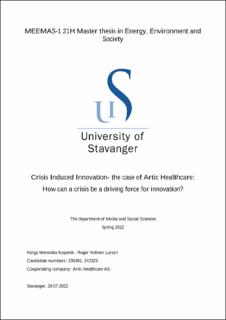| dc.description.abstract | Through this case study we examine the phenomenon of Crisis Induced Innovation, with the
purpose of exploring and further understanding the true nature of an emergency and how the
driving forces across the market dimensions function. We approached this topic with some
level of caution, as it is our first instinct to view a crisis as something inherently negative. The
topic of our research covers the Covid-19 pandemic as a driver for change across the many
different market dimensions, which we have elected to explore using theories within the fields
of socio-technical dynamics, emergency frames, innovation management, and rhetorical
situation. The overreaching objective that has been driving our academic focus is to
understand how a firm may capitalize on radical changes in market conditions and make an
adaptive move last beyond the crisis that caused the radical changes. Important notions of our
research have been to understand how the dynamic of acutely heightened demand would
affect the company in questions as the market returns to normalcy.
Our analytical approach towards this phenomenon were based on the notion of Crisis Induced
Innovation being the result of complex causal relationships that can be traced across market
dimensions through the utilization of relevant framework. Our predictions to start was that
Artic Healthcare, the company that served as a case study example for this purpose, started
their operations in the beginning of the pandemic, and elected to utilize the rapid changes to
speed up innovation processes.
Among our findings is that Crisis Induced Innovation, as a dynamic effect, is subjected to be
affected by its surroundings the same way it affects others. As we employed the MLP with a
focus on temporal dynamics, it became obvious that time was an essential element of how the
phenomenon evolves. However, we were not able to fully study these temporal dynamics and
gain an understanding of how far these pressure points can give an effect, as the case in
question reached a point in which progression stopped due to lack of funding for the
innovation case we studied. Despite this setback, we have been able to analyse how the
phenomenon affects the other dimensions through the employment of the multi-level
perspective, we have examined temporal dynamics through the employment of innovation
management theories that evaluates process speeds, and we have explored the complex nature
of the phenomenon by evaluating it from multiple frames simultaneously, which is presented
in our discussion. | |
